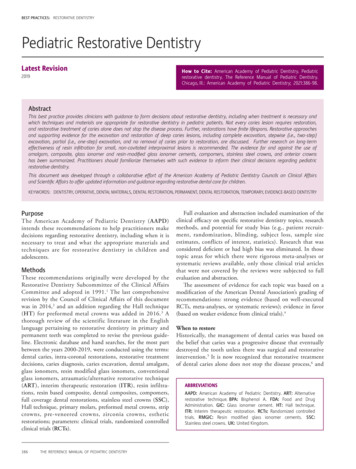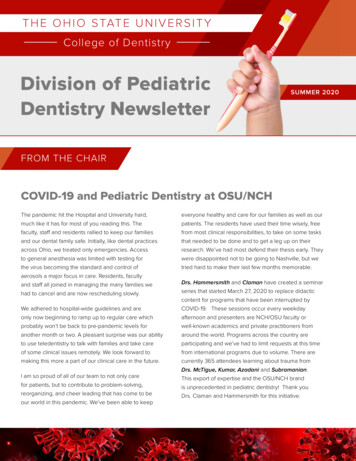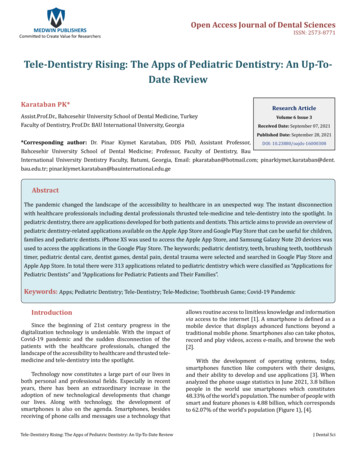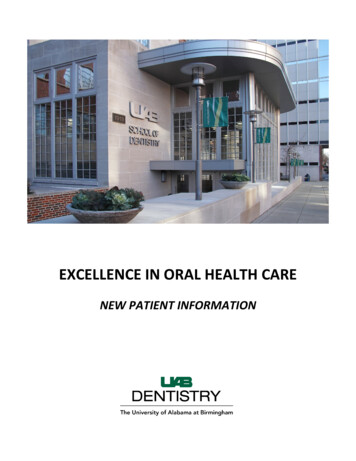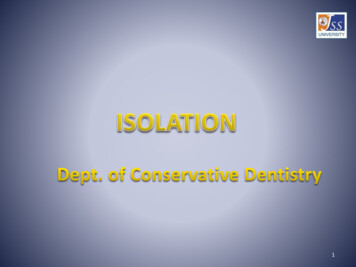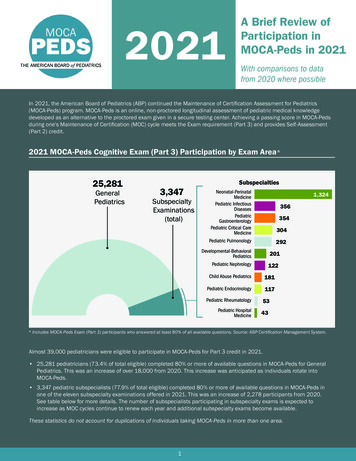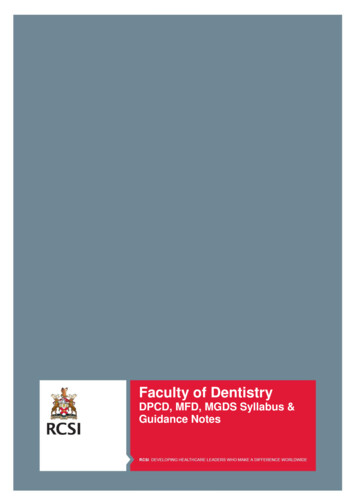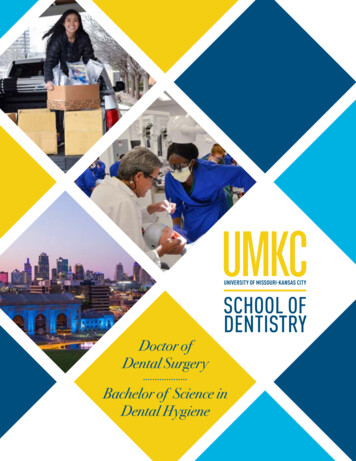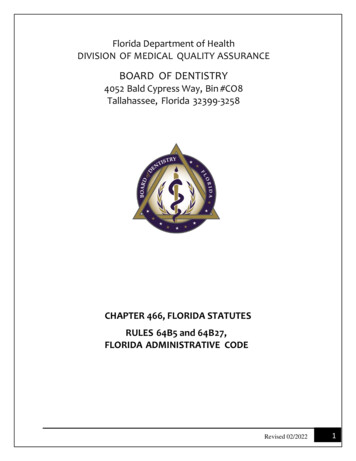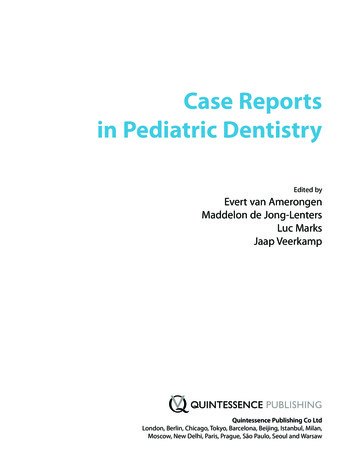
Transcription
Case Reportsin Pediatric DentistryEdited byEvert van AmerongenMaddelon de Jong-LentersLuc MarksJaap VeerkampQuintessence Publishing Co LtdLondon, Berlin, Chicago, Tokyo, Barcelona, Beijing, Istanbul, Milan,Moscow, New Delhi, Paris, Prague, São Paulo, Seoul and Warsaw
ForewordIt is essential that clinicians treating children have a high degree of awareness and knowledge of awide range of oral conditions to optimize the dental care for their patients. Some of these conditions are commonly encountered whereas others are rather infrequent, thus giving the practicingdentist limited experience to build up diagnostic and treatment skills. The latter may concern, forexample, different types of developmental disturbances such as hypodontia or disturbances of mineralization of dental hard tissues, as well as pathologic conditions in oral mucosa and bone. Of greatinterest in increasing knowledge and clinical experiences is the case reports/presentations, which,unfortunately to a limited extent, are published in pediatric scientific journals. This book has beenproduced in an attempt to overcome this and to give dentists involved in clinical dentistry for children an opportunity to a systematic approach in continuing education in diagnostics, indications,treatment, and follow-up of cases that could be seen in their own practices.In this book, 16 cases treated by experienced clinicians are presented, including case history,examination, diagnosis, indications for treatment, treatment options, and evaluation/prognosis.References for further reading are also given. The clinical pictures and radiographs are of excellentquality. The ambition of the editors to present a new book with new cases every other year is to becommended. This means that we can expect a library of first-class case presentations, which overtime will be of great importance for high quality care in dentistry for children.The present book is an outstanding, important contribution to achieving high standards in clinical children’s dentistry and also to stimulate discussions on treatment strategies. The book shouldbe available to all clinicians involved in dental care for children, it should be used in education, andto form a “case library” in all clinics/practices. This book can therefore be highly recommended.Göran KochV
PrefaceIn the Netherlands, as in several other countries in Europe and other parts of the world, there arespecialist training programs in pediatric dentistry. Postgraduate students are expected to collectmany case reports during this program. They get the opportunity to present these cases to only alimited number of colleagues, and after completion of their training there is a considerable chancethat those case reports disappear in a drawer. This observation was the basis of the idea to publisha series of books on those case reports in the Netherlands to give our Dutch colleagues the opportunity to learn from all these cases. However, after the publication of the first two volumes, itappeared that there was also a need and interest in neighboring countries for such purely clinicallyoriented books on pediatric dentistry. This interest set us the challenge to produce an identical bookin English, with case reports from different countries.This book is unique in pediatric dentistry; although there are many textbooks on children’s dentistry, there was a need for a concise collection of case reports. I hope that this book will not onlyserve as a reference for specialists in pediatric dentistry, but also help general practitioners in solving clinical problems related to their pediatric patients.On behalf of the authors,Evert van AmerongenVII
EditorsDr W Evert van Amerongen, Head of the Section of Pedodontology, Department of CariologyEndodontology Pedodontology and Oral Microbiology, Academic Centre for Dentistry in Amsterdam(ACTA), Amsterdam, The NetherlandsDr Maddelon de Jong-Lenters, Pediatric Dentist, Pediatric Dental Practice Cleyburch Noordwijk;Special Dental Care Centre MCA (Medical Centre Alkmaar) and Cariology EndodontologyPedodontology and Oral Microbiology, Academic Centre for Dentistry in Amsterdam (ACTA),Amsterdam, The NetherlandsProf. Dr Luc Marks, Pediatric Dentist, Pediatric Dental Department and Centre of Special Dental Care,University of Gent, Gent, BelgiumDr Jaap SJ Veerkamp, Pediatric Dentist, Department of Cariology Endodontology Pedodontology andOral Microbiology, Academic Centre for Dentistry in Amsterdam (ACTA), Amsterdam, The NetherlandsAuthorsSatu AlaluusuaDepartment of Paediatric and Preventive Dentistry, Institute of Dentistry, University of Helsinki, Finland,and Department of Oral and Maxillofacial Diseases and Hospital for Children and Adolescents, HelsinkiUniversity Central Hospital, Helsinki, FinlandHeikki AlapulliDepartment of Oral and Maxillofacial Diseases and Hospital for Children and Adolescents, HelsinkiUniversity Central Hospital, Helsinki, FinlandVeslemøy E. BjørkengPediatric Dentist, Risvollan Public Dental Clinic, Trondheim, NorwayKatharina BücherDepartment of Conservative Dentistry and Periodontology, Ludwig Maximilian University of Munich,GermanyRoeland De MoorDepartment of Operative Dentistry and Endodontology, Ghent Dental Laser Centre, Dental School,Ghent University Hospital, Ghent University, BelgiumMonty DuggalDental Institute, Department of Paediatric Dentistry, Leeds, UKIvar EspelidDepartment of Paediatric Dentistry and Behavioural Science, Faculty of Dentistry, University of Oslo,NorwayIX
Dafydd EvansSenior Lecturer, Preventive and Children’s Section, Dundee Dental Hospital and School, Dundee,ScotlandMario FazziDentistry Unit, Department of Head and Neck, University of Parma, ItalyRoland FrankenbergerDental Clinic 1 – Operative Dentistry and Periodontology, University Medical Center, Erlangen,GermanyReinhard HickelDepartment of Conservative Dentistry and Periodontology, Ludwig Maximilian University of Munich,GermanyMarie Therese HoseyDepartment of Paediatric Dentistry, King’s College London Dental Institute, London, UKMarie-Charlotte HuysmansDivision of Preventive and Curative Care, College of Dentistry, Radboud University Medical Centre,Radboud University Nijmegen, The NetherlandsNicola InnesClinical Lecturer, Preventive and Children’s Section, Dundee Dental Hospital and School, Dundee,ScotlandNorbert KrämerDepartment of Paediatric Dentistry, University Medical Center Carl Gustv Carus, Dresden, GermanyJan KühnischDepartment of Conservative Dentistry and Periodontology, Ludwig Maximilian University of Munich,GermanyManfredi MaddalenaDentistry Unit, Department of Head and Neck, University of Parma, ItalyMarie-Cècile ManièreDepartment of Paediatric Dentistry, Louis Pasteur University, Strasbourg, FranceLuc C. MartensDepartment of Paediatric Dentistry and Special Care, Ghent University, BelgiumRèmy MathisDepartment of Orthodontics, Louis Pasteur University, Strasbourg, FranceJulie Caroline MitchellDepartment of Paediatric Dentistry, King’s College London Dental Institute, London, UKAnne Grethe MyhrePaediatric Department, Rikshospitalet University Hospital, Oslo, NorwayFrèdèric ObryDepartment of Paediatric Dentistry, Louis Pasteur University, Strasbourg, FranceX
Marleen PeumansDepartment of Conservative Dentistry, School of Dentistry, Oral Pathology and Maxillo-Facial Surgery,Catholic University of Leuven, BelgiumSilvia PizziDentistry Unit, Department of Head and Neck, University of Parma, ItalyAndrea SaviDentistry Unit, Department of Head and Neck, University of Parma, ItalySven SimonsenPaediatric Department, Sykehuset Østfold, NorwayAnne B. SkaareDepartment of Paediatric Dentistry and Behavioural Science, Faculty of Dentistry, University of Oslo,NorwayIlija SkrinjaricDepartment of Paediatric Dentistry, School of Dental Medicine, University of Zagreb, CroatiaGert StelDivision of Preventive and Curative Care, College of Dentistry, Radboud University Medical Centre,Radboud University Nijmegen, The NetherlandsAnna Lena SundellDepartment of Paediatric Dentistry, Institute for Postgraduate Dental Education, Jönköping, SwedenMarco TamaniDentistry Unit, Department of Head and Neck, University of Parma, ItalyXI
Table of Contents1 Long-term Management of Early Childhood Caries . . . . . . . . . . . . . . . . . . . . . . . . . . . . . .1Norbert Krämer, Roland Frankenberger2 Hypomineralized Molars . . . . . . . . . . . . . . . . . . . . . . . . . . . . . . . . . . . . . . . . . . . . . . . . . . . . . . . . 9Marleen Peumans3 Dentinogenesis Imperfecta Type II . . . . . . . . . . . . . . . . . . . . . . . . . . . . . . . . . . . . . . . . . . . . . 17Satu Alaluusua, Heikki Alapulli4 Hypophosphatasia . . . . . . . . . . . . . . . . . . . . . . . . . . . . . . . . . . . . . . . . . . . . . . . . . . . . . . . . . . . . . 25Anne B. Skaare, Veslemøy E. Bjørkeng, Sven Simonsen, Anne Grethe Myhre, Ivar Espelid5 Non-operative Management of Dental Caries in the Primary Dentition . . . . . . . . 35Dafydd Evans, Nicola Innes6 Role of the Pediatric Dentist in Hypodontia . . . . . . . . . . . . . . . . . . . . . . . . . . . . . . . . . . . . 45Julie Caroline Mitchell, Marie Therese Hosey7 Erosive Dental Wear . . . . . . . . . . . . . . . . . . . . . . . . . . . . . . . . . . . . . . . . . . . . . . . . . . . . . . . . . . . .51Marie-Charlotte Huysmans, Gert Stel8 The Hall Technique: A Novel Method of Using Preformed Metal Crowns . . . . . . . .57Nicola Innes, Dafydd Evans9 Potential of Incomplete Caries Excavation to Arrest Active Caries Lesionsand to Maintain Pulp Vitality . . . . . . . . . . . . . . . . . . . . . . . . . . . . . . . . . . . . . . . . . . . . . . . . . . .65Jan Kühnisch, Katharina Bücher, Reinhard Hickel10 Management of Sequelae in the Permanent Incisors After Traumain the Primary Dentition . . . . . . . . . . . . . . . . . . . . . . . . . . . . . . . . . . . . . . . . . . . . . . . . . . . . . . . .75Frèdèric Obry, Rèmy Mathis, Marie-Cècile Manière11 Premolar Autotransplantation After Avulsionof Both Maxillary Central Incisors . . . . . . . . . . . . . . . . . . . . . . . . . . . . . . . . . . . . . . . . . . . . . . .83Luc C. Martens12 Prosthetic Rehabilitation in a Patient With Ectodermal Dysplasia . . . . . . . . . . . . . . .91Andrea Savi, Manfredi Maddalena, Marco Tamani, Mario Fazzi, Silvia Pizzi13 Tongue Piercing . . . . . . . . . . . . . . . . . . . . . . . . . . . . . . . . . . . . . . . . . . . . . . . . . . . . . . . . . . . . . . . .97Roeland De Moor14 Complicated Crown Fractures in Two Permanent Incisors . . . . . . . . . . . . . . . . . . . . . .105Ilija Skrinjaric15 Traumatic Bone Cyst . . . . . . . . . . . . . . . . . . . . . . . . . . . . . . . . . . . . . . . . . . . . . . . . . . . . . . . . . .113Anna Lena Sundell16 Pulp Therapy in the Primary Molars . . . . . . . . . . . . . . . . . . . . . . . . . . . . . . . . . . . . . . . . . . .119Monty DuggalAbbreviations . . . . . . . . . . . . . . . . . . . . . . . . . . . . . . . . . . . . . . . . . . . . . . . . . . . . . . . . . . . . . . . . .127Index . . . . . . . . . . . . . . . . . . . . . . . . . . . . . . . . . . . . . . . . . . . . . . . . . . . . . . . . . . . . . . . . . . . . . . . . . .128XIII
abcdefFig. 8-2a–f Sequence for fitting Hall crown to the mandibular right primary second molar (85) with use of a separator to create space mesially. 8-2a Lateral view prior to fitting crown. 8-2b Separator placed. 8-2c Separator removed 5 days later, showing space. 8-2d Crown being filled with glass ionomer cement. 8-2e Crown being placed on tooth. 8-2f Crown fitted. Glassionomer will be removed from between the mandibular right primary molar (84, 85) using dental floss.Four months after this, when Alistair was 51 2 years of age, his cooperation had improved sufficiently to allow radiographs to be taken (Figs 8-3a, 8-3b). These showed caries affecting the maxillary left primary first molar (64) and the mandibular right primary first molar (84). Initially theselesions were managed with prevention alone, but as they were noted to be progressive, with newcarious lesions developing on the maxillary right primary first molar (54) and the mandibular left primary first molar (74), Hall crowns were placed on all four first primary molars by the time the patientwas 6 years of age (Fig. 8-4). Whereas composite restorations may have been considered moreesthetic restorations for these teeth by the patient and his mother, they have not expressed any concern over the appearance of the crowns. Alistair was happy with the crowns and although his coop-60The Hall Technique: A Novel Method of Using Preformed Metal Crowns8
eration with treatment and ability to remain still in the dental chair were improving, it was unlikelythat he would have tolerated four individual appointments with local anesthetic and use of rotaryinstruments. In addition, moisture control may well have been difficult to maintain, compromisingthe quality of the restorations.abFig. 8-3 Bitewing radiographs(age 51 2 years). 8-3a Right bitewing radiograph; 8-3b left bitewing radiograph.Fig. 8-4 Anterior view (age 6 years 2 months) showing equal occlusalcontact on both sides and establishing permanent dentition.As the patient was clearly at increased risk of dental caries, the partially erupted first permanentmolars were fissure sealed with Fuji VII (GC) as a temporary measure, until they had erupted sufficiently to allow placement of resin sealants.History, clinical examination, and bitewing radiographs (Figs 8-5a to 8-5d) at 7 years of age (2years after the first, and 1 year after the last, Hall crowns were fitted) found no signs or symptoms ofpulpal disease and no new carious lesions. Alistair’s cooperation had also improved sufficiently toallow resin sealants to be placed on the first permanent molars.abcd8Fig. 8-5a–d Age 7 years. 8-5a,b Eight PMCs fitted using Hall techniqueand glass-ionomer temporary fissure sealants on the first permanentmolars. 8-1c,d Right and left bitewing radiographs.The Hall Technique: A Novel Method of Using Preformed Metal Crowns61
Dentistry Unit, Department of Head and Neck, University of Parma, Italy Roland Frankenberger Dental Clinic 1 - Operative Dentistry and Periodontology, University Medical Center, Erlangen, Germany Reinhard Hickel Department of Conservative Dentistry and Periodontology, Ludwig Maximilian University of Munich, Germany Marie Therese Hosey

